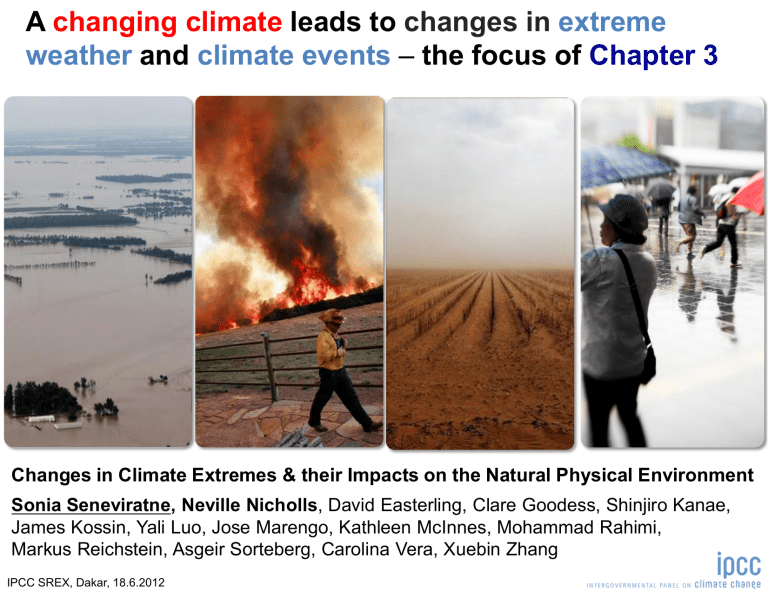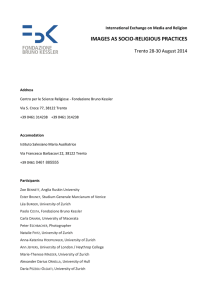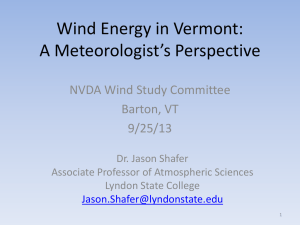Sonia Seneviratne, IPCC Coordinating Lead Author, SREX

A changing climate leads to changes in extreme weather and climate events – the focus of Chapter 3
Changes in Climate Extremes & their Impacts on the Natural Physical Environment
Sonia Seneviratne, Neville Nicholls , David Easterling, Clare Goodess, Shinjiro Kanae,
James Kossin, Yali Luo, Jose Marengo, Kathleen McInnes, Mohammad Rahimi,
Markus Reichstein, Asgeir Sorteberg, Carolina Vera, Xuebin Zhang
IPCC SREX, Dakar, 18.6.2012
S.I. Seneviratne, ETH Zurich
Overview of SREX Chapter 3
Changes in climate extremes and their impacts on the natural physical environment
• Some numbers:
1100 references, more than 70% post AR4;
>5’000 comments on chapter 3 material; ~4’600 CLA-CLA emails
• Complexities : observations/attribution/projections, variety of extremes
First time that literature on extremes was synthesized by a single team
• Regional assessments: observed and projected changes in extremes of temperature, heavy precipitation and drought for 26 regions
IPCC SREX, Dakar, 18.6.2012
S.I. Seneviratne, ETH Zurich
Since 1950, extreme hot days and heavy precipitation have become more common on the global scale
SREX provides new regional information with structured/formal assessment of uncertainty
There is evidence that anthropogenic influences, including increasing atmospheric greenhouse gas concentrations , have changed these extremes
IPCC SREX, Dakar, 18.6.2012
S.I. Seneviratne, ETH Zurich
SREX: 2-step assessment of uncertainty
Step 1
Assess confidence level
Low confidence
Medium confidence
Direction of change only
High confidence
Likelihood assessment
Step 2
Virtually certain (99-
100%)
Very likely
(90-100%)
Likely (66-
100%)
More likely than not (50-
100%)
About as likely as not
(33-66%)
IPCC SREX, Dakar, 18.6.2012
S.I. Seneviratne, ETH Zurich
Observed changes in temperature and precipitation extremes, including dryness, in African regions since 1950 (1961-90 baseline)
All
Africa
W.
Africa
(15)
Tmax (warm days
WD & cold days
CD) and Tmin
(warm nights WN & cold nights CN)
Low confidence to medium confidence depending on region:
Low confidence due to insufficient evidence (lack of literature) in many regions.
Medium confidence :
Increase in WD and decrease in CD (and generally CN ) in western centr. Africa,
Guinea Conakry,
Nigeria, and Gambia; lack of literature elsewhere for these indices . Increase in
WN in all region.
Heat waves/warm spells
Low confidence:
Insufficient evidence (lack of literature). Some analyses for localized regions
(see regional assessments).
Low confidence:
Insufficient evidence (lack of literature) for most of the region; increases in WSDI in Nigeria and
Gambia.
Heavy precipitation (HP)
Dryness (consecutive dry days
CDD, soil moisture anomalies
SMA & PDSI)
Low confidence:
Partial lack of data and literature and inconsistent patterns in existing studies.
See also regional assessments.
Medium confidence: Overall increase in dryness (SMA, PDSI); regional variability, 1970s long
Sahel drought dominates . No apparent continent-wide trends in change in rainfall over the 20th century. Wet season arrives 9
–21 days later.
Medium confidence:
Precipitation from
HP events has decreased (western central Africa,
Guinea Conakry) but low spatial coherence; rainfall intensity increased.
Medium confidence: 1970s
Sahel drought dominates, conditions are still drier (SMA,
PDSI, precip.) than during humid
1950s . Dry spell duration (CDD) overall increased from 1961 to
2000. Recent years characterized by a greater interannual variability than previous 40 yrs, west. Sahel remaining dry and the east. Sahel returning to wetter conditions.
See Table 3.2 for all African regions (Sahara, W. Africa, E. Africa, S. Africa) and full details
IPCC SREX, Dakar, 18.6.2012
S.I. Seneviratne, ETH Zurich
Projected changes in temperature and precipitation extremes, including dryness, in regions of Africa. For end of 21 st century vs end of
20 th century - GCMs/RCMs and A2/A1B.
Tmax (warm days WD & cold days CD) and
Tmin (warm nights WN & cold nights CN)
Heat waves/warm spells
Heavy precipitation (HP) Dryness (consecutive dry days CDD, soil moisture anomalies
SMA & PDSI)
All
Africa
High confidence
WD/WN likely to increase and
CD/CN likely to decrease in all regions.
High confidence:
Likely more frequent and/or longer heat waves and warm spells
Low confidence to high
confidence depending on region : Inconsistent change or no signal in HP indicators across much of continent.
Strongest and most consistent signal is likely increase in HP in E. Africa.
Low confidence to medium confidence depending on region : Low confidence in most
regions; medium confidence of increase in dryness (CDD, SMA) in southern Africa except eastern part
W.
Africa
(15)
High confidence
WD/WN likely to increase and
CD/CN likely to decrease .
High confidence:
Likely more frequent and/or longer heat waves and warm spells
Low confidence to medium
confidence depending on subregion : Medium confidence in slight or no change in HP indicators in most of region; Low confidence due to low model agreement in northern
Low confidence:
Inconsistent signal of change in CDD and SMA.
part of region.
See Table 3.3 for all African regions (Sahara, W. Africa, E. Africa, S. Africa) and full details
IPCC SREX, Dakar, 18.6.2012
S.I. Seneviratne, ETH Zurich
For the first time, estimates of the magnitude of changes in some extremes are provided
In many of the 26 regions considered, the time between “20-year” (unusually intense) hot extremes will decrease , and the events occurring only every 20 year are projected to become more intense (Fig. 3-5a,b)
IPCC SREX, Dakar, 18.6.2012
S.I. Seneviratne, ETH Zurich
For the first time, estimates of the magnitude of changes in some extremes are provided
In many of the 26 regions considered, the time between “20-year” (unusually intense) hot extremes will decrease, and the events occurring only every 20 year are projected to become more intense (Fig. 3-5a,b)
IPCC SREX, Dakar, 18.6.2012
S.I. Seneviratne, ETH Zurich
SREX Projections: Dryness assessments
Consistent projections of increased dryness in the Mediterranean region, central Europe, central North America, C. America and Mexico, NE Brazil, and southern Africa ( SREX large regions )
W. Africa: No consistent signal within whole region, but some consistent signal in the western part of region (including Senegal) based on SREX figure
IPCC SREX, Dakar, 18.6.2012
S.I. Seneviratne, ETH Zurich
SREX Projections: Dryness assessments
Consistent projections of increased dryness in the Mediterranean region, central Europe, central North America, C. America and Mexico, NE Brazil, and southern Africa ( SREX large regions )
W. Africa: No consistent signal within whole region, but some consistent signal in the western part of region (including Senegal) based on SREX figure
IPCC SREX, Dakar, 18.6.2012
S.I. Seneviratne, ETH Zurich
Also assessed changes in phenomena related to weather & climate extremes, and impacts on physical environment:
Monsoons
• Low confidence in observed trends and their attribution due to insufficient evidence
• Low confidence in projected changes due to insufficient agreement between climate models
Extreme sea level and coastal impacts
• Likely increase in extreme coastal high water worldwide related to increases in mean sea level in the late 20 th century
• Likely anthropogenic influence on observed changes via mean sea level contributions
• Very likely that mean sea level rise will contribute to upward trends in extreme coastal high water levels
• High confidence that locations currently experiencing coastal erosion and inundation will continue to do so due to increasing sea level, in the absence of changes in other contributing factors
See Table 3.
1
IPCC SREX, Dakar, 18.6.2012
S.I. Seneviratne, ETH Zurich
Summary for West Africa
• Temperature extremes : Observed increase in hot extremes and decrease in cold extremes (medium confidence); likely projected continuation of these trends; projected increase of hot extremes of the order of 4 ° for A2 scenario
• Heavy precipitation: Not very clear signal either for observations nor for projections; some observed increased in precipitation intensity
• Droughts: In observed trends, 1970s Sahel drought still dominate the overall signal; projected sign of change unclear in most of West Africa
(projections smaller scale would require refinement of regions)
• Sea level rise: of importance for coastal regions
• Data quality: Lack of suitable observational datasets & studies for most extremes in Africa (e.g. no studies for Senegal assessed)
Improved information on regional level also requires regional input
(e.g. data for model validation!)
IPCC SREX, Dakar, 18.6.2012
S.I. Seneviratne, ETH Zurich
IPCC SREX, Dakar, 18.6.2012
S.I. Seneviratne, ETH Zurich
Merci pour votre attention!
14
IPCC SREX, Dakar, 18.6.2012
S.I. Seneviratne, ETH Zurich
Increasing vulnerability, exposure, or severity and frequency of climate events increases disaster risk
• SREX provides significantly expanded information on the severity and frequency of extreme climate events compared to AR4 - in particular on the regional scale
• Level of certainty in projection strongly depends on the considered extreme, region and season
IPCC SREX, Dakar, 18.6.2012
S.I. Seneviratne, ETH Zurich









